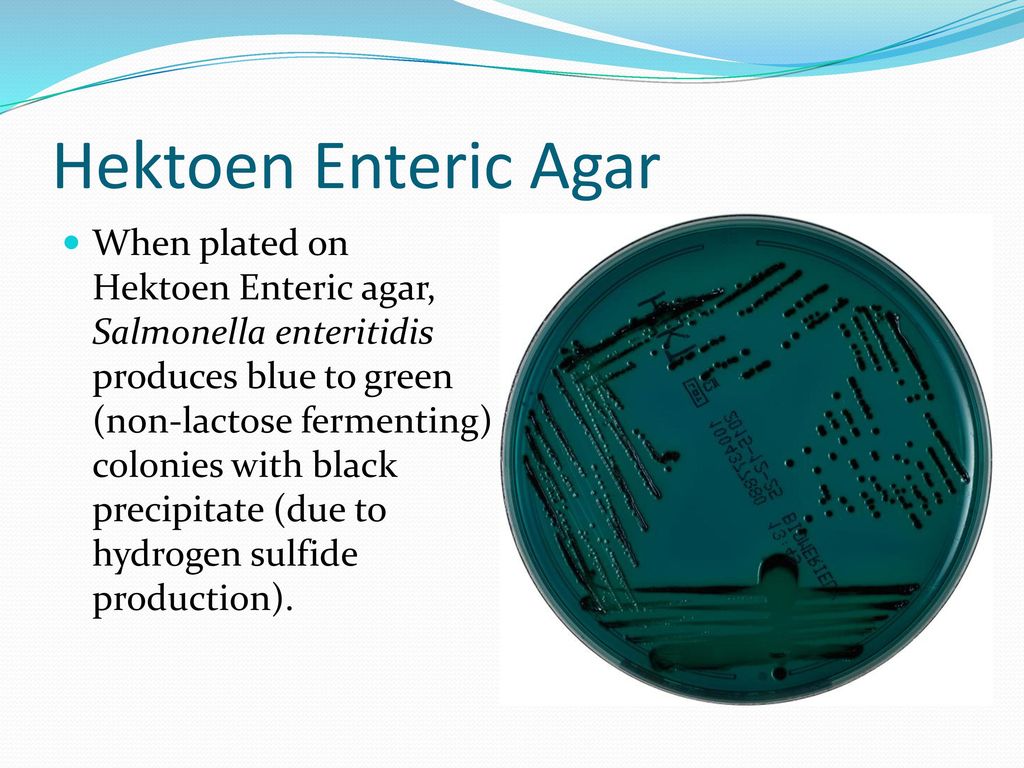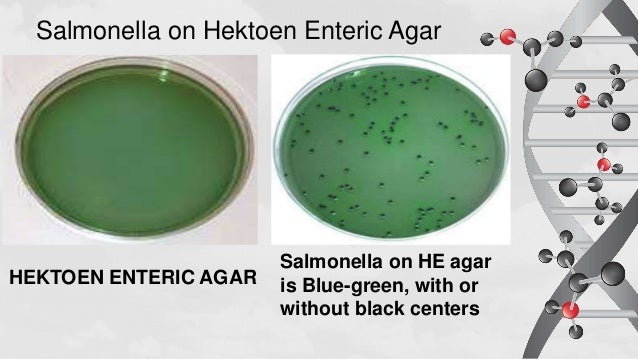Salmonella Agar Hektoen / Salmonella Shigella Ss Agar Composition Principle Procedure And Results Learn Microbiology Online - Hektoen enteric agar is a differential and selective medium for the isolation of shigella and salmonella spp.
Salmonella Agar Hektoen / Salmonella Shigella Ss Agar Composition Principle Procedure And Results Learn Microbiology Online - Hektoen enteric agar is a differential and selective medium for the isolation of shigella and salmonella spp.. (1) bromothymol blue and acid fuchsin as indicators of carbohydrate dissimilation and (2) ferric iron as an indicator of the formation of hydrogen sulfide from thiosulfate. Hektoen enteric agar (hek, he or hea) is a selective and differential agar primarily used to recover salmonella and shigella from patient specimens. Hektoen enteric agar was formulated by kind and metzger and meets the requirements of the This medium, which distinguishes salmonella and shigella from other members of the enterobacteriaceae, was developed in 1968 by sylvia king and william i. The additional carbohydrates (sucrose and salicin) give better differentiation than lactose alone and the lower toxicity of the double indicator improves recovery.
This is also known as hek and hea. This medium, which distinguishes salmonella and shigella from other members of the enterobacteriaceae, was developed in 1968 by sylvia king and william i. The difference between salmonella sp., shigella sp., and rapid fermenters Some shigella spp., such as s. Bile salts and the dyes bromthymol blue and acid fuchsin inihibit the growth of most gram positive organisms.

On this agar medium, shigella produces colorless, translucent colonies.
The medium was introduced in 1968 by sylvia king and william i. Bile salts and the dyes bromthymol blue and acid fuchsin inihibit the growth of most gram positive organisms. The additional carbohydrates (sucrose and salicin) give better differentiation than lactose alone and the lower toxicity of the double indicator improves recovery. Metzger at the hektoen institute in chicago (hence, the name hektoen enteric agar to honor their place of employment). This helps microbiologists identify the organisms, and is actually representative of differences in the enzymes produced by different species, which normally allow them to utilize nutrients in their environments. Some shigella spp., such as s. This medium, which distinguishes salmonella and shigella from other members of the enterobacteriaceae, was developed in 1968 by sylvia king and william i. Biolife italiana s.r.l., milan, italy) and observed after 3 to 5 min for the development of fluorescence produced in the presence of the c8 esterase enzyme. Hea contains indicators of lactosefermentation and hydrogen sulfideproduction; Hektoen enteric agar productinformation product number h7532 product description hektoen enteric agar is a differential selective medium used for the isolation of shigella and salmonella species from enteric pathological specimens. Hektoen enteric agar (he) is a selective and differential medium designed to isolate and differentiate members of the species salmonella and shigella from other enterobacteriaceae. This medium is particularly useful in the isolation of shigella species. Fue creado en el instituto hektoen por king y metzger para el aislamiento de bacterias enteropatógenas de los géneros shigella y salmonella.
Mix (vortex, if tube) and streak 3 mm loopful (10 µl) incubated tt broth on bismuth sulfite (bs) agar, xylose lysine desoxycholate (xld) agar, and hektoen enteric (he) agar. On this agar medium, shigella produces colorless, translucent colonies. Taylor, w.i., and schelhart, d. Hea contains indicators of lactose fermentation and hydrogen sulfide production; Some shigella spp., such as s.

This medium is particularly useful in the isolation of shigella species.
Mix (vortex, if tube) and streak 3 mm loopful (10 µl) incubated tt broth on bismuth sulfite (bs) agar, xylose lysine desoxycholate (xld) agar, and hektoen enteric (he) agar. Mannitol salt agar and baird parker rpf; The additional carbohydrates (sucrose and salicin) give better differentiation than lactose alone and the lower toxicity of the double indicator improves recovery. On this agar medium, shigella produces colorless, translucent colonies. This is also known as hek and hea. On hektoen agar, salmonella colonies appear black, whereas escherichia species form colonies that are orange. Hektoen enteric agar (he) is a selective and differential medium designed to isolate and differentiate members of the species salmonella and shigella from other enterobacteriaceae. Hektoen enteric agar is a differential and selective medium for the isolation of shigella and salmonella spp. It relies on the use of bile salts for selective inhibition and two indicator systems: Some shigella spp., such as s. Hektoen enteric agar(hek, heor hea) is a selective and differential agarprimarily used to recover salmonellaand shigellafrom patient specimens. Taylor, w.i., and schelhart, d. Hea contains indicators of lactose fermentation and hydrogen sulfide production;
Hektoen enteric agar (he) is a selective and differential medium designed to isolate and differentiate members of the species salmonella and shigella from other enterobacteriaceae. Bile salts and the dyes bromthymol blue and acid fuchsin inihibit the growth of most gram positive organisms. Mix (vortex, if tube) and streak 3 mm loopful (10 µl) incubated tt broth on bismuth sulfite (bs) agar, xylose lysine desoxycholate (xld) agar, and hektoen enteric (he) agar. The high peptone content offsets the inhibitory effect of bile salts on shigella species in particular. This medium, which distinguishes salmonella and shigella from other members of the enterobacteriaceae, was developed in 1968 by sylvia king and william i.

Bile salts and the dyes bromthymol blue and acid fuchsin inihibit the growth of most gram positive organisms.
Hektoen enteric (he) agar developed in 1968 by sylvia king and william i. Some shigella spp., such as s. This is also known as hek and hea. Fue creado en el instituto hektoen por king y metzger para el aislamiento de bacterias enteropatógenas de los géneros shigella y salmonella. Bile salts and the dyes bromthymol blue and acid fuchsin inihibit the growth of most gram positive organisms. Mix (vortex, if tube) and streak 3 mm loopful (10 µl) incubated tt broth on bismuth sulfite (bs) agar, xylose lysine desoxycholate (xld) agar, and hektoen enteric (he) agar. Hektoen enteric agar is a selective and differential medium designed to isolate and differentiate members of the species salmonella and shigella from other enterobacteriaceae. The additional carbohydrates (sucrose and salicin) give better differentiation than lactose alone and the lower toxicity of the double indicator improves recovery. This medium is particularly useful in the isolation of shigella species. Hektoen enteric agar (he) is a selective and differential medium designed to isolate and differentiate members of the species salmonella and shigella from other enterobacteriaceae. Hea contains indicators of lactose fermentation and hydrogen sulfide production; Hektoen enteric agar hiện nay được sử dụng như môi trường cấy trực tiếp hoặc gián tiếp để khôi phục các tác nhân gây bệnh đường tiêu hóa, như salmonella và shigella, từ thực phẩm, nước, và mẫu phân nghi ngờ có nhiễm sinh vật này. Hektoen enteric agar (hek, he or hea) is a selective and differential agar primarily used to recover salmonella and shigella from patient specimens.
Komentar
Posting Komentar